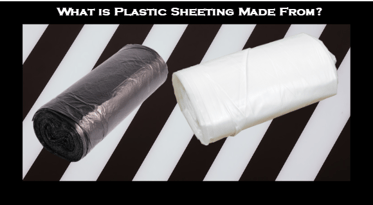Plastic Sheeting is made from various components

Plastic sheeting is made from a variety of materials, including polyethylene, polypropylene, polyvinyl chloride, and polyester. The most common type of plastic sheeting is made from polyethylene, which is a type of thermoplastic. Thermoplastics are materials that can be melted and re-shaped, which makes them ideal for manufacturing plastic sheeting.
The specific type of plastic used to make plastic sheeting will depend on the desired properties of the sheeting. For example, polyethylene sheeting that is used for construction purposes will need to be strong and durable, while polyethylene sheeting that is used for food packaging will need to be food-grade and non-toxic.
How Is Plastic Sheeting Manufactured?
The manufacturing process for plastic sheeting begins with the production of plastic resin. Plastic resin is a raw material that is made from petroleum or natural gas. The resin is then melted and extruded through a die, which creates the desired shape of the sheeting. The sheeting is then cooled and hardened.
Plastic sheeting is a versatile material that can be used for a variety of purposes. It is often used for construction, agriculture, food packaging, and shipping. Plastic sheeting is also used in a variety of other applications, such as as a protective barrier, a moisture barrier, and a sound barrier.
Here are some of the most common types of plastic sheeting:
- Polyethylene sheeting: Polyethylene sheeting is the most common type of plastic sheeting. It is strong, durable, and water-resistant. Polyethylene sheeting is often used for construction, agriculture, and food packaging.
- Polypropylene sheeting: Polypropylene sheeting is more expensive than polyethylene sheeting, but it is also stronger and more durable. Polypropylene sheeting is often used for industrial applications, such as as conveyor belts and protective barriers.
- Polyvinyl chloride (PVC) sheeting: PVC sheeting is a rigid plastic sheeting that is often used for roofing and siding. PVC sheeting is also used for pipes and other plumbing fixtures.
- Polyester sheeting: Polyester sheeting is a strong, lightweight plastic sheeting that is often used for tents and other outdoor gear. Polyester sheeting is also used for sails and other marine applications.
There are many different types of flexible plastic sheeting, each with its own unique properties. Some common types of flexible plastic sheeting include:
- Tarpaulins: Tarpaulins are heavy-duty sheets of plastic that are used to protect goods from the elements.
- Cling film: Cling film is a thin, transparent sheet of plastic that is used to wrap food.
- Bubble wrap: Bubble wrap is a sheet of plastic with small air bubbles that is used to cushion fragile items during shipping.
Flexible plastic sheeting can be used for a variety of purposes, including:
-
- Construction: Flexible plastic sheeting is often used as a temporary roof or siding during construction.
- Agriculture: Flexible plastic sheeting is used to cover crops to protect them from the elements.
- Gardening: Flexible plastic sheeting is used to create greenhouses and cold frames.
- Shipping: Flexible plastic sheeting is used to protect goods during shipping.
- Industrial: Flexible plastic sheeting is used in a variety of industrial applications, such as as a conveyor belt or as a protective barrier.
There are many benefits to using flexible plastic sheeting, including:
-
- Durability: Flexible plastic sheeting is very durable and can withstand a variety of weather conditions.
- Water resistance: Flexible plastic sheeting is water resistant and can be used to protect goods from moisture.
- Transparency: Flexible plastic sheeting is transparent, which allows light to pass through.
- Cost-effectiveness: Flexible plastic sheeting is a cost-effective way to protect goods and to create temporary structures.
Can Plastic Sheeting be Recycled?
Flexible plastic sheeting can be recycled by melting it down and re-forming it into new products. However, not all types of flexible plastic sheeting can be recycled, and it is important to check with your local recycling center to see if they accept flexible plastic sheeting.Plastic sheeting is a versatile material that has a wide range of applications. It is important to choose the right type of plastic sheeting for the specific application to ensure that the sheeting will meet the desired requirements.

